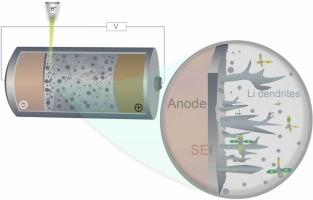液相透射电子显微技术研究锂离子电池阳极-电解质界面:成就、挑战和未来方向
IF 17.1
1区 材料科学
Q1 CHEMISTRY, PHYSICAL
引用次数: 0
摘要
锂离子电池的电化学性能受到阳极-电解质界面复杂相互作用的强烈影响,直接影响电池的效率、循环寿命和安全性。液相透射电子显微镜(LP-TEM)已成为现场观察该界面上发生的动态过程的关键技术。许多研究已经调查了这些复杂的界面过程,它们经常相互补充,偶尔重叠,有时提出矛盾的发现。在这项工作中,我们概述了发生在阳极-电解质界面的关键过程,最广泛使用的LP-TEM装置来研究它们,以及从这些研究中获得的知识的当前状态。此外,我们讨论了现有的挑战,强调了需要进一步研究的领域,并提出了未来的研究方向,旨在克服这些限制,以加深我们对锂离子电池阳极-电解质界面电化学机制的理解。本文章由计算机程序翻译,如有差异,请以英文原文为准。

Anode-electrolyte interface in lithium-ion batteries investigated by liquid phase transmission electron microcopy: Achievements, challenges, and future directions
The electrochemical performance of lithium-ion batteries (LIBs) is strongly influenced by the complex interactions at the anode-electrolyte interface, which directly affect the battery's efficiency, cycle life, and safety. Liquid-phase transmission electron microscopy (LP-TEM) has become a key technique for in situ observations of the dynamic processes occurring at this interface. Numerous studies have investigated these complex interfacial processes, often complementing each other, occasionally overlapping, and sometimes presenting contradictory findings. In this work, we provide an overview of the key processes occurring at the anode-electrolyte interface, the most widely used LP-TEM setup to study them, and the current state of knowledge derived from these studies. Furthermore, we discuss the existing challenges, highlight areas that require further investigation, and propose future research directions aimed at overcoming these limitations to deepen our understanding of electrochemical mechanisms at the anode-electrolyte interface in LIBs.
求助全文
通过发布文献求助,成功后即可免费获取论文全文。
去求助
来源期刊

Nano Energy
CHEMISTRY, PHYSICAL-NANOSCIENCE & NANOTECHNOLOGY
CiteScore
30.30
自引率
7.40%
发文量
1207
审稿时长
23 days
期刊介绍:
Nano Energy is a multidisciplinary, rapid-publication forum of original peer-reviewed contributions on the science and engineering of nanomaterials and nanodevices used in all forms of energy harvesting, conversion, storage, utilization and policy. Through its mixture of articles, reviews, communications, research news, and information on key developments, Nano Energy provides a comprehensive coverage of this exciting and dynamic field which joins nanoscience and nanotechnology with energy science. The journal is relevant to all those who are interested in nanomaterials solutions to the energy problem.
Nano Energy publishes original experimental and theoretical research on all aspects of energy-related research which utilizes nanomaterials and nanotechnology. Manuscripts of four types are considered: review articles which inform readers of the latest research and advances in energy science; rapid communications which feature exciting research breakthroughs in the field; full-length articles which report comprehensive research developments; and news and opinions which comment on topical issues or express views on the developments in related fields.
 求助内容:
求助内容: 应助结果提醒方式:
应助结果提醒方式:


